
The straw underwing is a moth of the family Noctuidae. The species was first described by Johann Siegfried Hufnagel in 1766. It is found from North Africa west through South Europe and Central Europe. In the north it is in parts of Ireland, Scotland, Sweden, Norway, Finland and Estonia. Further east the range stretches from southern Russia and Asia minor to the Caucasus.

Acronicta cuspis, the large dagger, is a moth of the family Noctuidae. It is distributed through most of Europe, Northern Africa (Morocco), the European part of Russia, the Caucasus, the Russian Far East, southern Siberia, Transcaucasia, central Asia, China, Japan and the Korean Peninsula.

Mythimna vitellina, the delicate, is a moth of the family Noctuidae. The species was first described by Jacob Hübner in 1808. It is mainly distributed throughout southern Europe and the southern part of eastern Europe. It is also found far less commonly further north in Europe. Also in North Africa, the Near East and Middle East, Central Asia and western China.

Caradrina kadenii, or Clancy's rustic, is a moth of the family Noctuidae. The species was first described by Christian Friedrich Freyer in 1836. It originates from southern and central Europe, Asia Minor and southern Russia but in the 21st century it has extended its range to the north.

Condica is a genus of moths of the family Noctuidae. The genus was erected by Francis Walker in 1856.

Abrostola asclepiadis is a moth of the family Noctuidae. It is found in South and Central Europe as far north as Finland and Sweden, Asia Minor and the Caucasus.

The Essex y is a moth of the family Noctuidae. It is found from Italy to Greece, southeastern Europe, southwestern Russia, the southern parts of the Ural, Africa, Canary Islands, Arabia, southwestern Asia, Ceylon, from India to Nepal, southeastern China and Japan.

Dichagyris musiva is a moth of the family Noctuidae. It is found in some mountainous areas of Europe, Turkey, Armenia, the Caucasus, Anatolia, southern Siberia, Mongolia, Tibet and western China.
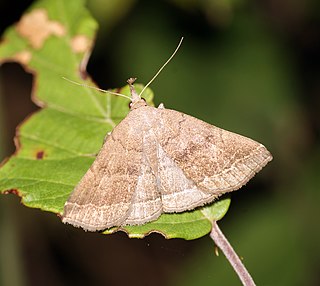
Polypogon plumigeralis, the plumed fan-foot, is a species of litter moth of the family Erebidae found in Africa, Asia and Europe. It was first described by the German entomologist Jacob Hübner in 1825.

Euxoa aquilina is a moth of the family Noctuidae. It is found in the Mediterranean region of Europe, North Africa, the Near East and the Middle East.
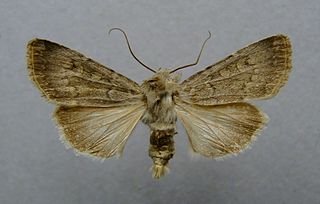
Euxoa decora is a moth of the family Noctuidae. It is found in southern and central Europe, Morocco, Algeria, the Caucasus, Armenia, Issyk-Kul, Turkey, Iran and Iraq.

Euxoa hastifera is a moth of the family Noctuidae. It is found from southern Europe to Siberia and Tajikistan.

Apamea sublustris, the reddish light arches, is a moth of the family Noctuidae. The species was first described by Eugenius Johann Christoph Esper in 1788. It is found in central and southern Europe, Turkey and the Caucasus.

Dichagyris constanti is a moth of the family Noctuidae. It is found in Algeria, Morocco, south-western Europe, southern France, and northern Italy. Warren (1914) states E. constanti Mill. Forewing pale yellow, dusted with darker especially in median area; the lines fine ; the subterminal punctiform ; stigmata very faint ; hindwing white, with the fringe and margin yellowish.Recorded only from the Ardeche, France.
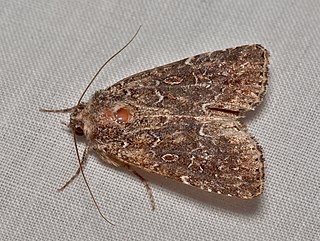
Condica capensis is a moth of the family Noctuidae. It is found across Africa, the Indian sub-continent and South-East Asia. In Europe, it is only common in southern Spain, but can be found further north.
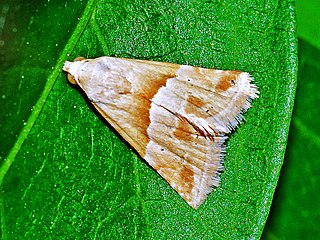
Eublemma parva, the small marbled, is a moth of the family Erebidae. The species was first described by Jacob Hübner in 1808.

The Brighton wainscot is a moth of the family Noctuidae.

Callopistria latreillei, Latreille's Latin, is a moth of the family Noctuidae. The species can be found in the Palearctic realm, most parts of Europe, Asia, and in Africa from Egypt to South Africa. The habitat consists of rocky limestone slopes with deciduous woodland.

Athetis hospes, or Porter's rustic, is a moth of the family Noctuidae which was described by Christian Friedrich Freyer in 1835. It is found in Spain, southern France, Italy, on the Balkan Peninsula, Crete, Turkey and northern Iran. The species seems to be expanding its range in north-western Europe with records from Great Britain and the Netherlands.
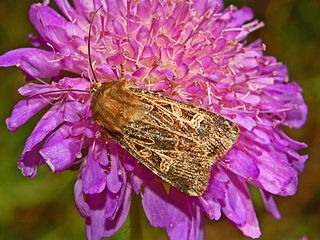
Chersotis alpestris is a moth of the family Noctuidae.



















